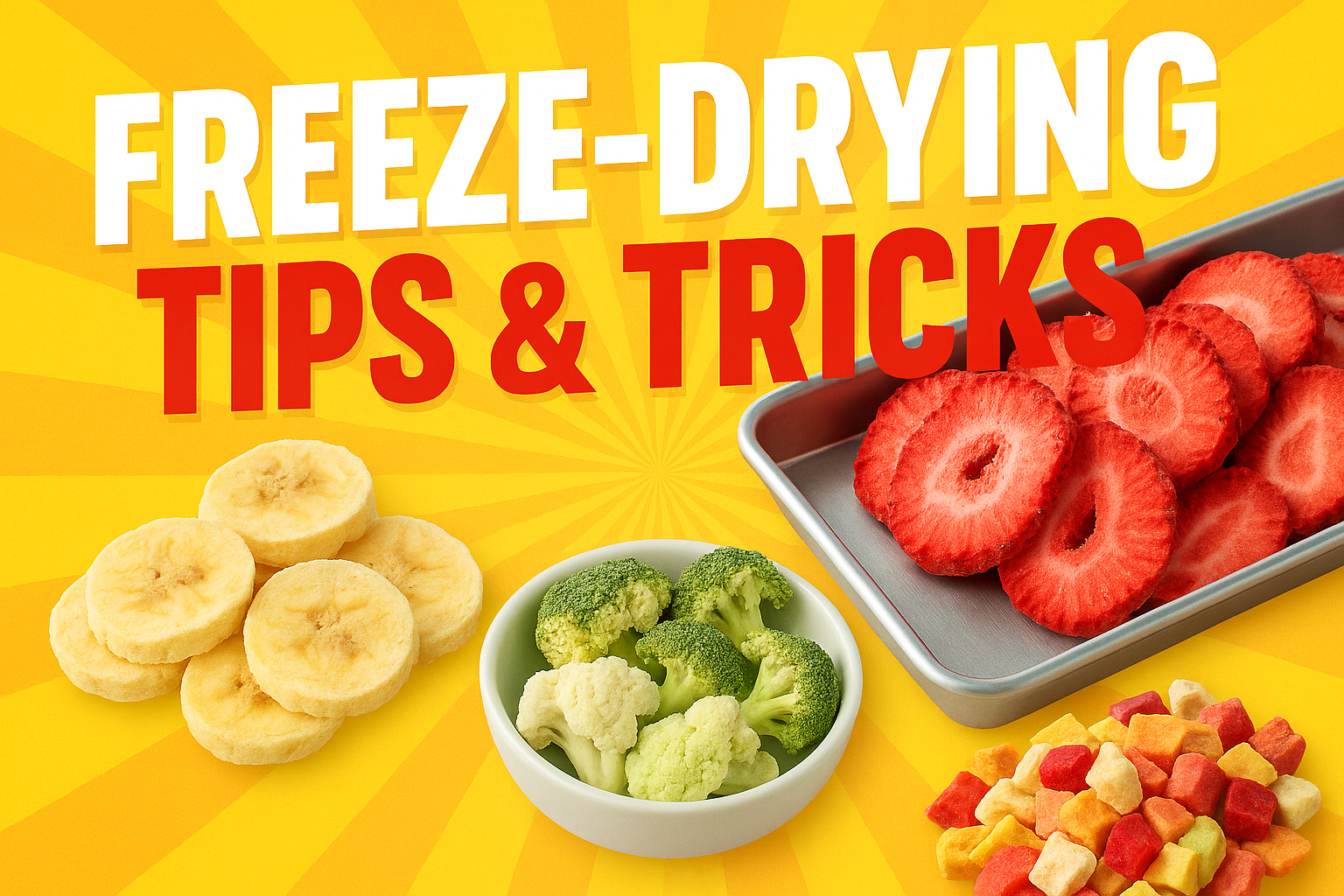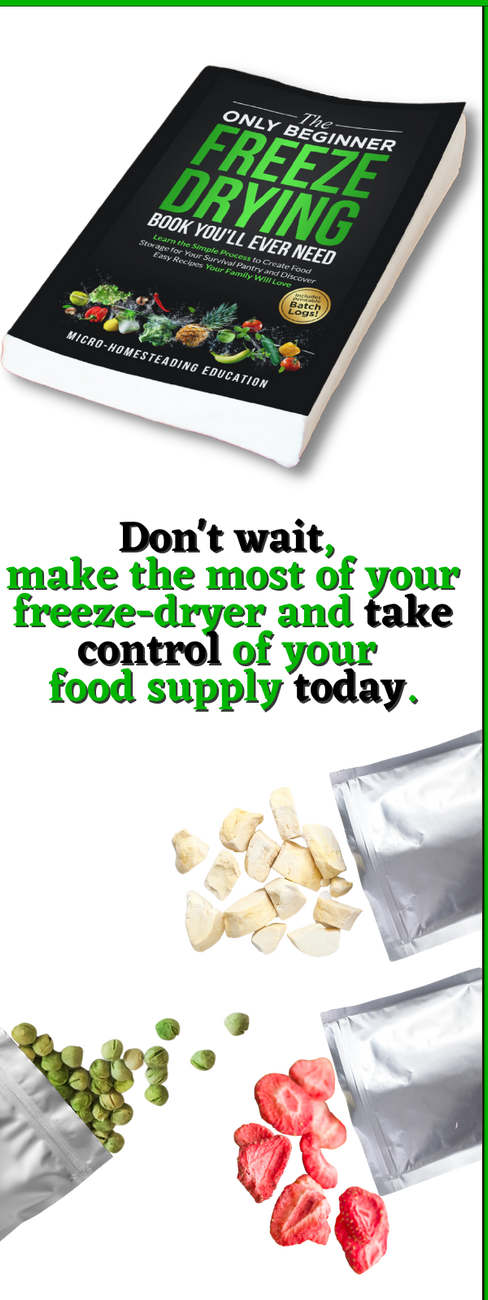Tips and Tricks for Freeze-Drying

Your freeze-dryer is a versatile appliance that can help you preserve and enjoy a wide range of foods. However, like any tool, there are tricks and tips that can make your freeze-drying journey safer and more successful.
In this article, we'll explore some random but valuable tips to ensure your freeze-drying adventures are both enjoyable and fruitful. Tips and Tricks for Freeze-Drying
1. Follow the Freeze-Drying Rules
Before we delve into specific tips, it's essential to emphasize the importance of following the freeze-drying rules provided by Harvest Right™ in their manual and on their website.
These guidelines are designed to ensure your safety and the optimal performance of your freeze-dryer. Familiarize yourself with these rules and refer to them as needed throughout your freeze-drying process. Tips and Tricks for Freeze-Drying
2. Trial and Error: Freeze-Drying Times
One of the unique aspects of freeze-drying is that the exact time required for each type of food can vary based on your specific machine and environment. While you can find general guidelines for freeze-drying times, it's essential to experiment and determine the ideal times for your situation.
Don't be afraid to start freeze-drying and adjust times as needed to achieve the desired results. Your machine and conditions are unique, so embrace the learning process.
3. Weigh Your Trays for Reliable Results
A simple and reliable way to determine if your freeze-dried food is ready for packaging is to weigh your trays. Here's how to do it:
- Weigh your trays at the end of the freeze-dry run.
- Give them an extra dry time of two hours.
- Re-weigh the trays.
- If the weight hasn't changed, your food is completely dry and safe for storage.
This method provides a clear indication of whether your food is adequately freeze-dried, eliminating any guesswork.
4. Seed-Containing Foods Need Extra Time
Foods with seedsrequire additional freeze-drying time, such as:
- Strawberries
- Blueberries
- Tomatoes
Run these foods for at least six hours longer than usual before performing the two-hour weight check.
The seeds retain moisture, and extended freeze-drying ensures thorough preservation.
5. Extra Dry Time
When your freeze-dryer switches to "Extra Dry" time, it's not an automated process but a signal for you to check on the food. This is your opportunity to weigh the trays and make sure everything is proceeding as expected. The human element plays a crucial role in freeze-drying, so stay involved throughout the process.
6. Use a Towel to Collect Drips
During intensive freeze-drying cycles, your machine may produce moisture that drips from the front of the freeze-dryer. Placing a towel underneath can help collect any moisture, keeping your workspace clean and dry.
7. Quick Defrost
For a faster defrosting process, wear gloves when removing ice from the chamber. As the ice cracks off, it can be removed before it completely melts, expediting the defrosting phase.
8. Consider a Continuous SealerIf you encounter issues with your impulse sealer, some users have found success by purchasing a continuous sealer. This alternative sealing method can provide more consistent and reliable results for packaging your freeze-dried products. |
9. Temperature Fluctuations Are NormalIt's entirely normal for the temperature in the freeze-dryer chamber to fluctuate significantly during the process. These fluctuations, alternating between very cold and very warm, are part of the freeze-drying process and should not be a cause for concern. |
10. Blanch Raw PotatoesIf you plan to freeze-dry raw potatoes, always blanch them before the freeze-drying process. Failure to do so can result in blackened potatoes. Blanching ensures a better freeze-drying outcome, especially for starchy vegetables. |
11. Preserve Fruit Freshness with Lemon JuiceTo keep fruits like apples, pears, and bananas looking fresh and vibrant, consider dipping them in a lemon juice wash. Mix one tablespoon of lemon juice with each cup of water to create a solution that can help prevent browning and preserve their appearance. |
12. Patience with Pineapple
Pineapple is known for its extended freeze-drying time, often running for up to 72 hours. Don't be surprised if this happens. Remember that if it is still sticky, it is not done yet. Pineapple's high sugar content can result in longer processing times.
13. Blanching vs. Cooking Green Beans
For optimal results, use blanched green beans instead of cooked ones. Blanching helps retain the texture and color of green beans during the freeze-drying process.
14. Selecting Bananas for Freeze-Drying
When freeze-drying bananas, choose bananas that are just ripe with a few freckles. Overripe bananas have higher sugar content and may bubble up during freeze-drying, affecting the quality of the end product. Also, provide a little space between banana slices on the tray to prevent sticking.
15. Avoid Vacuuming Without Freezing
Never run the vacuum without first running the freezer. Operating the vacuum without freezing can introduce moisture from the drum into your pump, causing the oil to turn cloudy.
To avoid this issue, ensure the freeze-dryer is properly prepped before vacuuming.
16. Don't Worry About Curling Silicone Mats
With these additional tips and tricks, you'll be better equipped to navigate your freeze-drying journey successfully. Whether you're a seasoned freeze-drying enthusiast or just getting started, these insights can help you make the most of your freeze-dryer, ensure the safety of your preserved foods, and enjoy the many benefits of home freeze-drying.






